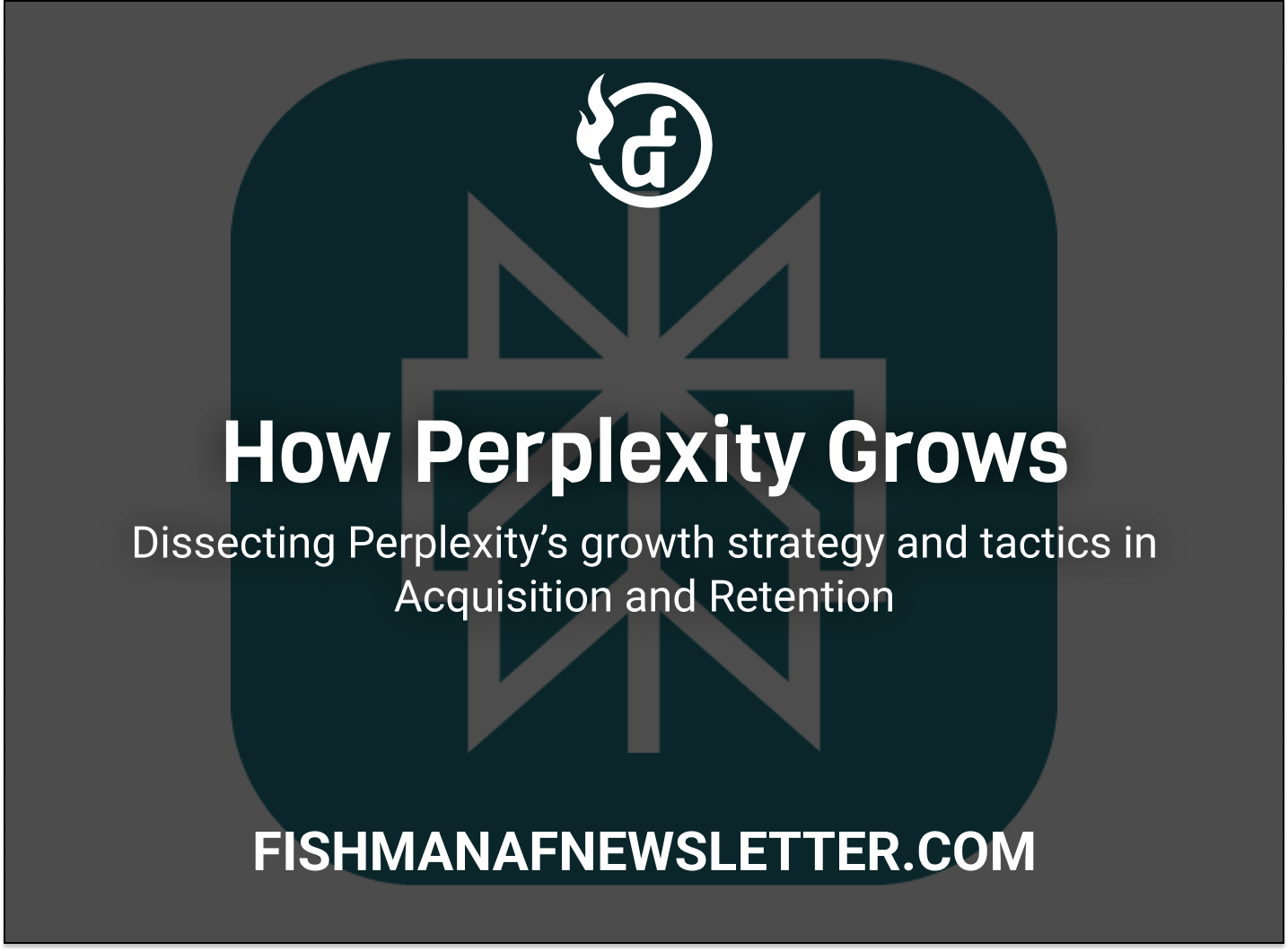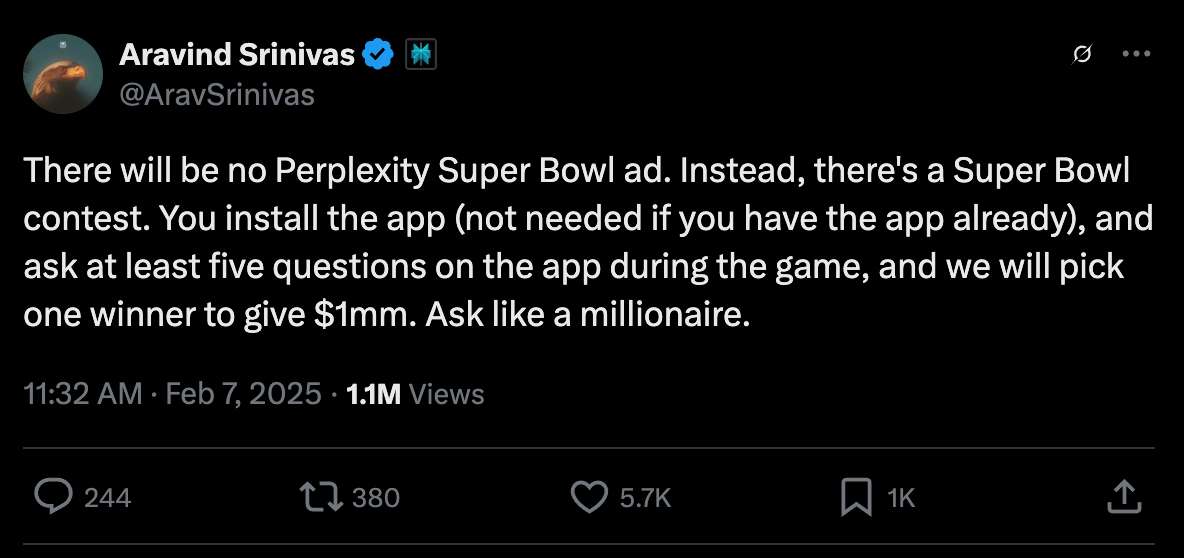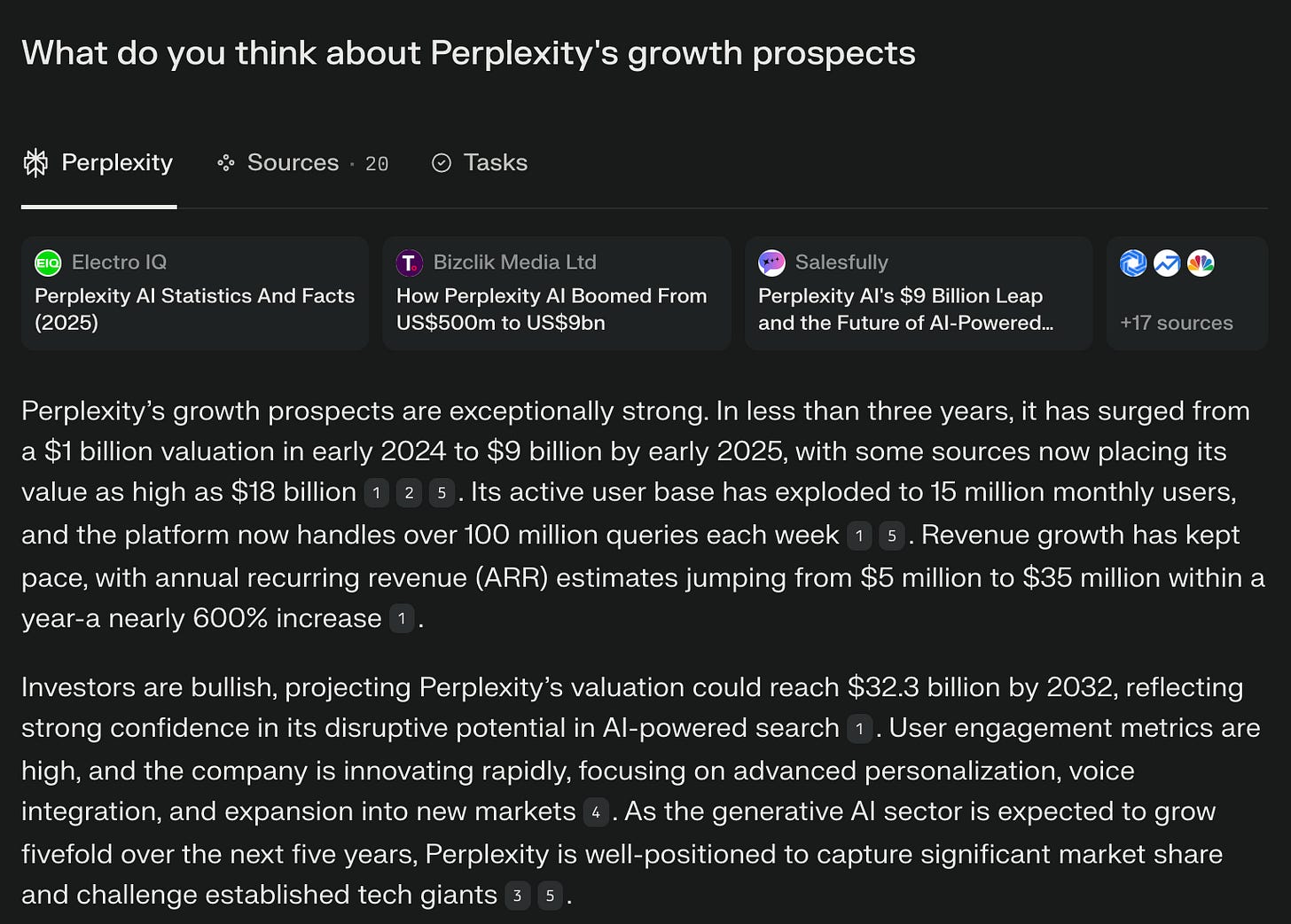How Perplexity Grows
Dissecting Perplexity’s growth strategy and tactics in Acquisition and Retention
Hi there, it’s Adam. I started this newsletter to provide a no-bullshit, guided approach to solving some of the hardest problems for people and companies. That includes Growth, Product, and company building. Subscribe and never miss an issue. If you’re a parent or parenting-curious I’ve got a Webby Award Honoree podcast on fatherhood and startups - check out Startup Dad. Questions you’d like to see me answer? Ask them here.
This is part of a series on how the biggest AI companies are growing. I covered ChatGPT here awhile back.
I am fascinated by Perplexity. I’ve been a Pro subscriber since January 2024 and about 12 months ago it replaced Google as my default search engine. As I’ve written about before, defaults are powerful.
The last "publicly available” data for Perplexity from about 6 months ago claimed that they were doing 400 million queries per month. I imagine it’s much higher than that currently but competition is also heating up. Anthropic, OpenAI, Google’s Gemini, and Microsoft all have either added real-time search to their existing chat interfaces or have search engines that incorporate AI in their results.
It’s obvious that Perplexity has tried a lot of different strategies to grow their product and I probably haven’t even seen all of them yet. In this newsletter I’ll examine the various growth levers I’ve identified that keep Perplexity user numbers moving up and to the right. I’ve left out monetization because currently I don’t think that Perplexity is doing anything different or novel than any of the other foundation model companies are doing – they have consumer/prosumer product, an enterprise product, and they charge for API usage.
Acquisition
Linear Channels
Linear channels are those that feed (or cold start) growth loops but aren’t inherently sustainable loops themselves. These are activities like: brand marketing, press, brand-oriented SEO, conferences, events, etc.
The Perplexity team is no stranger to linear channels, the most recent being their Super Bowl stunt.
This was an interesting tactic on several dimensions:
Super bowl ads are massively expensive and OpenAI and Google were already running their own.
Asking 5 questions drives usage of the product which gets people closer to an “aha” moment and feeds their system with more content. I’m willing to bet that retention is related to questions asked over a given time period.
It created way more viral excitement than a super bowl commercial; even the best ones.
They paired this with a New Orleans-based Cybertruck “street team” event to create more buzz.
CEO + AskPerplexity on X/Twitter
Another linear channel that Perplexity has is their CEO’s presence on Twitter and their corresponding AskPerplexity handle (more on that below). He has ~255,000 followers as of this writing and posts somewhere between 2-10x per day. AskPerplexity has a similar amount. That’s enough to drive initial adoption and interest in new features. The AskPerplexity handle also covers some of the more real-time and newsworthy activity happening – everything from the trial of P Diddy, to birth rates, Warren Buffet retiring, and of course: product and feature announcements.
While neither of these are truly self-perpetuating “loops” in the classic sense they do provide fuel for the actual loops at the company.
User Generated Content Loops
Let’s start with one of the more interesting loops that builds off of the AskPerplexity handle: the Twitter user loop.
You can see how it works in this post:
https://x.com/AskPerplexity/status/1894227029769310243
This is similar to the integration with Twitter and Grok (from xAI) but launched ~2 weeks earlier than Grok did.
It works exactly as it says above – you tag AskPerplexity in a post, you ask a question about the post or the replies, and Perplexity replies with the answer via public tweet. People see both the initial tagging of AskPerplexity and Perplexity’s response. This then leads new people to want to tag AskPerplexity on follow-ups feeding the loop while driving distribution and awareness for Perplexity.
This is a simple user generated / user distributed content loop built off the back of the Twitter/X platform.
Perplexity has taken this several steps further by also integrating this functionality with Discord, Telegram, and WhatsApp. It’s the gift that keeps on giving!
This is a perfect example of finding a loop that works on one platform and then copying that loop to as many platforms as possible. It also plays into one of Perplexity’s brand promises that “search” can happen anywhere and as part of any conversation.
And it appears to be working quite well: https://x.com/AravSrinivas/status/1916975376498364613
The AskPerplexity loop also acts as a double loop in that it drives both acquisition and retention. If I weren’t a power user of Perplexity and saw it mentioned in all the comments in my Twitter/X feed it would remind me to try it again.
AskPerplexity This isn’t the only user generated content loop that exists at Perplexity though, they’ve also built Spaces, Pages and Share functionality.
Pages
Around the end of May of last year (2024) they launched Pages which allows people to create… well… pages. It’s similar to functionality that exists in Notion. You can turn a search or set of research into a shareable webpage. Here’s one that Perplexity made for me based on a “Weekend Trip to Yosemite” template:
By itself, this functionality is interesting but not a growth loop. But notice the “Publish” button in the upper right corner. Clicking that makes this page public:
And here it is:
https://www.perplexity.ai/page/weekend-trip-to-yosemite-LeoVQP0PRaWZuX8L6XU2dw
Visiting this page takes you to a landing page that displays a variety of Perplexity functionality. That’s neat and makes it worth sharing.
But there’s one other big thing that publishing does – it allows the page to be crawled by Google and makes it both a user generated / user distributed content loop and a user generated / company distributed (via search/SEO) loop. There’s an irony here as Perplexity is trying to overtake Google in the long term; for now though it still brings much-needed traffic.
I can’t say for sure that this drove the movement in the graph below, but there is a steady up-and-to-the-right growth in organic traffic that appears to have accelerated initially with the launch of Pages.
Share
When I wrote about how ChatGPT grows last year I included this screenshot of Perplexity’s share functionality with a criticism:
“Perplexity has gotten this right, but there’s too much going on. Do I copy the link or do I share? And if I share, why are there so many choices? Also, does anyone share to Facebook anymore?”
Since the writing of that post they’ve gone ahead and simplified the experience. Sharing now looks like this:
Nice job Perplexity team! 👏👏 It would appear that, in fact…no one shares to Facebook anymore. I don’t use this sharing functionality personally, I just copy the URL with a keyboard shortcut, but for some folks this is probably an important part of the process. Facilitating an observed behavior by making it easier and more obvious to do is a good experiment to run and it looks like it worked because they’ve since iterated further on the share experience.
Spaces
In October of last year Perplexity launched Spaces. The concept behind spaces is to turn a single-player experience into a multiplayer one and as this newsletter has covered in the past (thanks Lauryn!) it’s a good strategy. Spaces makes it easy for users to collaborate on research; you can organize threads (Perplexity’s conversational AI), invite people to join the space, and customize how the AI responds.
The point of Spaces is collaboration. This serves two purposes: driving adoption within companies and across them. Given that Perplexity rolled this out with a push for their Enterprise Pro product my hunch is that the internal, cross-company adoption is what they’re going for here.
Much like pages and threads you can share, but this one comes with a handy email invite experience. You can see what the invite looks like below. I had some trouble with the landing experience - it loaded a blank page so either that’s a broken flow or user error (hey, just because I know a lot about growth and product doesn’t mean I don’t make mistakes on the internet).


There’s one more interesting aspect of Perplexity’s acquisition experience that bridges the gap between acquisition and activation (retention). That is the Discover section.
Discover
In early 2024 Perplexity launched the Discover daily podcast (which appears to be discontinued as of a month or two ago). But they still have a Discover Tab which you can see here:
On the Lex Friedman podcast conversation with Perplexity’s CEO, Aravind talked about the Discover tab:
“That’s why on our Discover tab, we’re building a timeline for your knowledge. Today it’s curated but we want to get it to be personalized to you. Interesting news about every day. So we imagine a future where the entry point for a question doesn’t need to just be from the search bar. The entry point for a question can be you listening or reading a page, listening to a page being read out to you, and you got curious about one element of it and you just asked a follow-up question to it.”
Discover is helpful as a starting point to using Perplexity, it feeds into the sharing engine, and provides a “template” for the type of queries you can ask. Giving guardrails and examples for an otherwise infinitely horizontal product is something we’ve seen emerge in lots of companies and especially the foundation model consumer experiences.
In my newsletter about ChatGPT growth, I talk about the importance of this for the foundation model companies:
“You can think of Custom GPTs like you’d think of templates. One of the challenges with a completely horizontal product like ChatGPT and other LLMs is that it can be difficult to get started or know what to ask. It’s why most of them include some sort of prompt examples in the interface…”
This is also what you see at other horizontal companies – like Notion, Canva, and anything where starting with a blank canvas is daunting.
So Discover helps people onboard to Perplexity but also gives them a reason to come back. The “timeline for your knowledge” as Aravind calls it.
Speaking of retention, let’s examine some of the retention strategies of Perplexity.
Retention
With so much competition and feature overlap it’s really tough to build long-term habits with answer-based AI tools. Users are trying so many different tools right now and models are leapfrogging each other constantly in their usefulness and performance on different tasks.
The most powerful of Perplexity’s retention loops is the environmental habit loop of the “default search engine.”
In Arc, for example, you can select Perplexity as the default in your profile settings replacing Google.
You can do this (albeit with a bit more effort) in Chrome, Edge, Firefox, Brave and all the other chromium-based browsers. Safari, unfortunately for Perplexity, hasn’t gotten on the bandwagon yet unless you use a 3rd party tool. Womp womp.
The Perplexity Desktop App probably helps a little bit with retention as well, but browser-based searches still dominate and likely will for a long time. At least for the foreseeable future it’s where work happens.
Related Queries
While likely designed to drive deeper engagement the related queries functionality is a way for users to spend more time exploring (and getting value) out of Perplexity. Here’s how this looks for a search about who won the latest Golden State Warriors game:
You can see that Perplexity prompts me to ask more questions and makes that easy via the ➕button on the right. Each query to Perplexity comes with these additional, related queries at the bottom.
Onboarding
Perplexity was one of the first to introduce a zero-friction onboarding experience. Initially ChatGPT, Claude, Pi and others all made you jump through some hoops or create an account before you could engage.
While ChatGPT has figured out that’s not all that helpful, Claude still hasn’t (c’mon Claude!). There’s a subtle hypocrisy in Claude calling themselves the privacy-first AI but then making you create an account.
Perplexity, on the other hand, doesn’t require an account and never really has. It’s probably a minor nuisance to create an account with Claude but there is almost certainly some drop-off in their experience vs. Perplexity’s.
So now you might be thinking:
“But Adam, if they don’t make you create an account how could they possibly re-engage with you?”
Fair point, they do suggest it pretty strongly after you’ve had the opportunity to ask some questions so they’re getting you closer to value with the combination of friction-free onboarding and related queries. You’re much more likely to sign up after that point.
Speaking of re-engagement, Perplexity experimented with email digests within the past 6 months.
Email Digest
The email digest is a tried and true manufactured habit loop that attempts to re-engage with users by sending them some updates around once-per-week. I only received a few of them and then either unsubscribed or Perplexity stopped sending them… I honestly can’t remember which, but if I had to guess I’d say that it didn’t work as a retention lever. I don’t even have a screenshot of it anymore because I deleted them all.
Watchlists
This is a really interesting recent development from February ‘25. They started with watchlists for sports teams and stock tickers. They let users track specific teams or stocks within Perplexity and provide personalized, real-time updates. Today the watchlist is customizable from your profile:
Allegedly the watchlist is supposed to be available as a widget on your homepage. That wasn’t working for me unfortunately either because of user error (again) or because Perplexity is updating this functionality. When it’s live, it’ll be somewhat useful for making Perplexity’s homepage more of a destination for you to return to regularly. Building on that you could imagine notifications when important updates happen within your watchlists although that could get unwieldy really fast. Time will tell!
Wrapping Up
In some areas Perplexity has done a lot to enable features and functionality that drive growth. In other areas, like manufacturing retention, they seem to have invested less. This could be because their retention is really strong or that as a small team they’re relentlessly focused on getting new users to start using the product.
There are a few elements that I’ll hypothesize contribute to their success:
Acquisition Loops
They have introduced a lot of self-reinforcing growth loops. AskPerplexity integration across multiple, large communication and social hubs, pages and spaces all leverage other platforms or the power of collaboration to drive adoption. In doing so they’ve built mechanisms where users will naturally drive other users to the platform.
Friction Reduction
This is less of a lever now than it was when they were the only one doing it, but by eliminating signup requirements they’ve removed the barrier between “I have a question” and “Perplexity has the answer.” It drives an incremental percentage of users through their experience and gets more people to value as a result.
Default Search Engine
It’s very likely that aside from some of their double loops (like AskPerplexity) the most powerful retention strategy is becoming the “default” search engine on as many browsers as possible. It also may be the reason that they’re looking to build their own browser–a herculean task that I wouldn’t particularly recommend btw–so that they can attempt to own the OS where work happens. It’s a steep hill to climb so we’ll see how that turns out for them.
In closing, I’ll leave you with Perplexity’s own take on their growth prospects. Perhaps not surprising, they’re bullish!
See you next time,
Adam






















I’m a huge fan of Perplexity, I’ve got my PRO subscription from Lenny’s Newsletter bundle and I’ve been an addict since then. 😂
I love how deep this post is, great insights!
Thanks for sharing! This is so awesome!